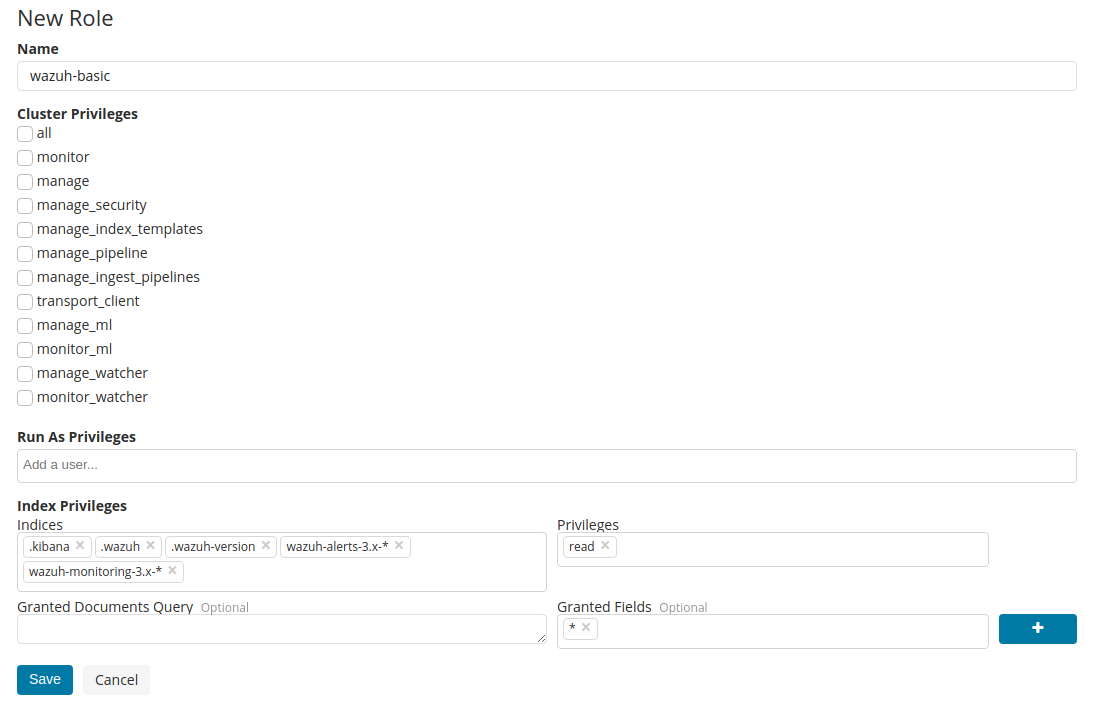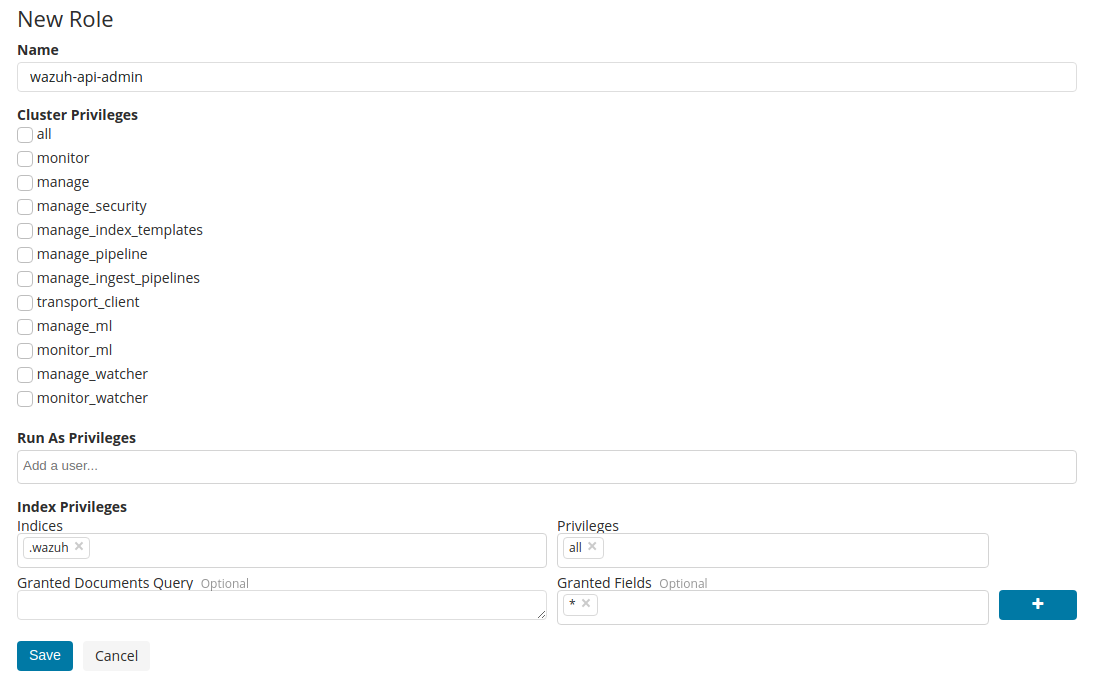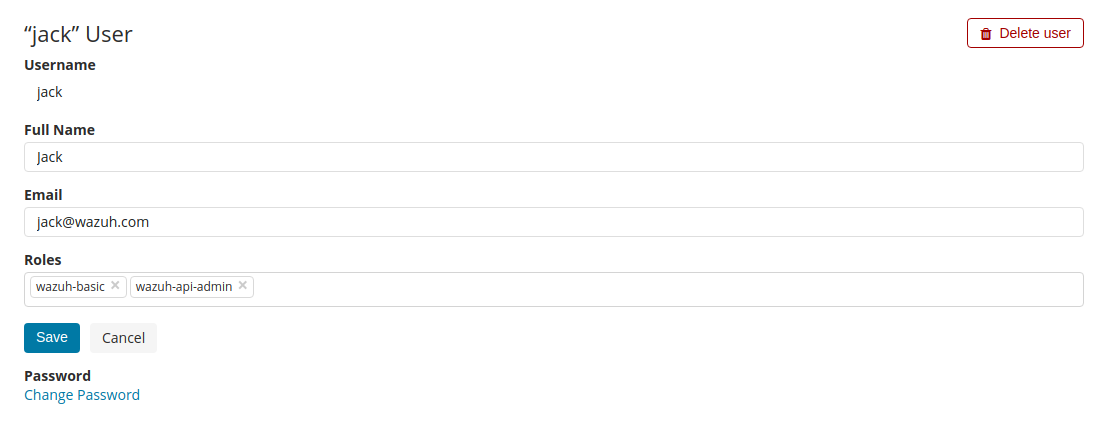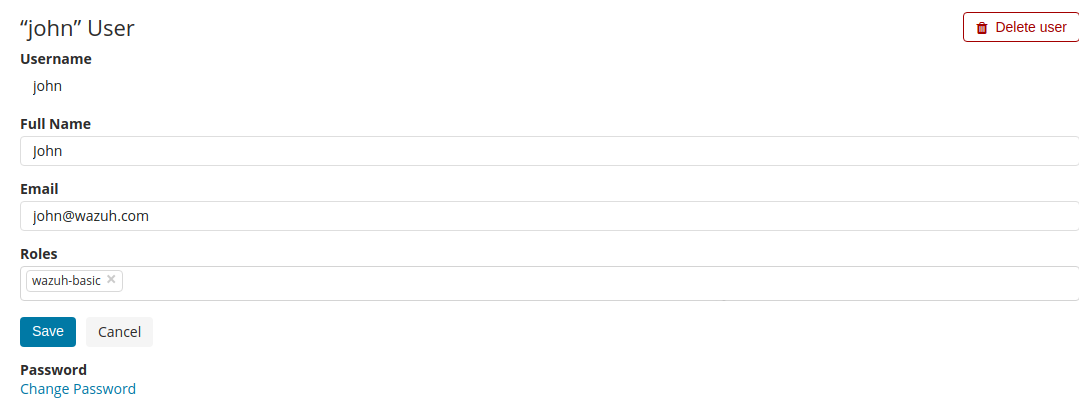Configure X-Pack users
This section helps to configure the X-Pack users and roles mentioned on the previous article, using the interface provided by Kibana.
Using Kibana UI with the elastic user
Login into Kibana using the
elasticuser:

Go to Management > Security > Roles:

Create the
wazuh-adminrole:

Create the
wazuh-basicrole:

Create the
wazuh-api-adminrole:

Go to Management > Security > Users:

Create the Wazuh administrator user:

Create a standard user:
Note
This user is not able to add/remove/edit a Wazuh API, use the Wazuh administrator user instead (step 7).

Create the Kibana system user:
Warning
Ensure the password is strong enough, it will be the superuser for your environment.

Set the right user credentials on the
kibana.ymlfile:
# vi /etc/kibana/kibana.yml elasticsearch.username: "wazuhsystem" elasticsearch.password: "<wazuhsystem_password>"
Restart Kibana:
# systemctl restart kibana
Using the command-line interface (CLI)
Create the
wazuh-adminrole:
# curl -XPOST "http://localhost:9200/_xpack/security/role/wazuh-admin" -H 'Content-Type: application/json' -d' { "cluster": [ "manage", "manage_index_templates" ], "indices": [ { "names": [ ".old-wazuh", ".wazuh", ".wazuh-version", "wazuh-*" ], "privileges": ["all"] } ] }' -u elastic:elastic_password {"role":{"created":true}}
Create the
wazuh-basicrole:
# curl -XPOST "http://localhost:9200/_xpack/security/role/wazuh-basic" -H 'Content-Type: application/json' -d' { "cluster": [], "indices": [ { "names": [ ".kibana", ".wazuh", ".wazuh-version", "wazuh-alerts-3.x-*", "wazuh-monitoring-3.x-*" ], "privileges": ["read"] } ] }' -u elastic:elastic_password {"role":{"created":true}}
Create the
wazuh-api-adminrole:
# curl -XPOST "http://localhost:9200/_xpack/security/role/wazuh-api-admin" -H 'Content-Type: application/json' -d' { "cluster": [], "indices": [ { "names": [ ".wazuh" ], "privileges": ["all"] } ] }' -u elastic:elastic_password {"role":{"created":true}}
Create the Kibana system user:
Warning
Ensure the password is strong enough, it will be the superuser for your environment.
# curl -XPOST "http://localhost:9200/_xpack/security/user/wazuhsystem" -H 'Content-Type: application/json' -d' { "password": "wazuhsystem", "roles":["wazuh-admin","kibana_system"], "full_name":"Wazuh System", "email":"wazuhsystem@wazuh.com" }' -u elastic:elastic_password {"user":{"created":true}}
Create the Wazuh administrator user:
# curl -XPOST "http://localhost:9200/_xpack/security/user/jack" -H 'Content-Type: application/json' -d' { "password": "jackjack", "roles":["wazuh-basic","wazuh-api-admin"], "full_name":"Jack", "email":"jack@wazuh.com" }' -u elastic:elastic_password {"user":{"created":true}}
Create a standard user:
Note
This user is not able to add/remove/edit a Wazuh API, use the Wazuh administrator user instead (step 5).
# curl -XPOST "http://localhost:9200/_xpack/security/user/john" -H 'Content-Type: application/json' -d' { "password": "johnjohn", "roles":["wazuh-basic"], "full_name":"John", "email":"john@wazuh.com" }' -u elastic:elastic_password {"user":{"created":true}}
Set the right user credentials on the
kibana.ymlfile:
# vi /etc/kibana/kibana.yml elasticsearch.username: "wazuhsystem" elasticsearch.password: "<wazuhsystem_password>"
Restart Kibana:
# systemctl restart kibana